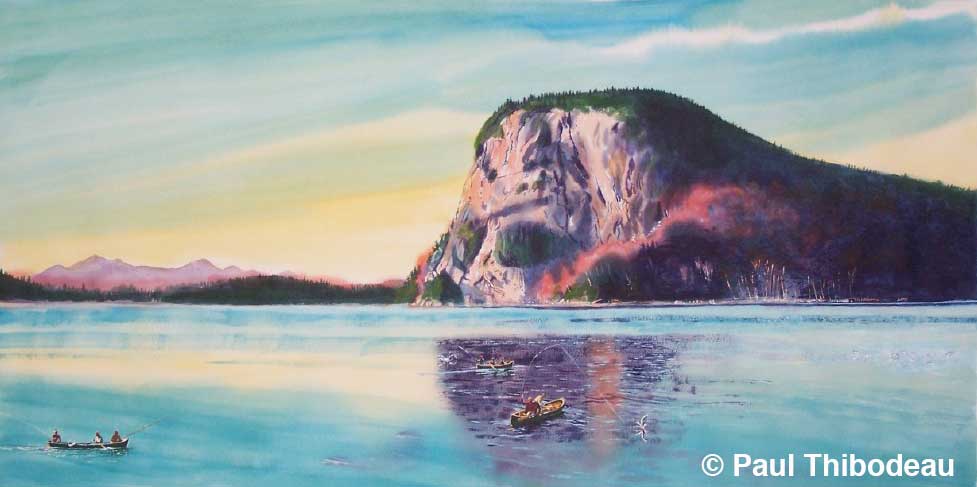Last week, my wife came across an online LA Times article that she thought I should read. The article was about the decline of the larger Coho salmon on the west coast of the US. The following is a synopsis of that information and it just might be pertinent to our reduced number of Atlantic salmon.
Scientists on the west coast of the US have been frustrated by the reduction of the Coho salmon population for more than 20 years. Similar to Maine, millions of dollars have been spent in the restoring of streams in Seattle, Washington. Making stream beds less silty, and building gravel beds for the salmon to lay their eggs were key in the restoration. Researchers were thrilled when the Coho salmon reappeared following those improvements. But, when it rained and stormwater filled the streams, more than half, and sometimes all of the salmon would die. This strange phenomenon had stumped biologists for decades. Their tests had eliminated pesticides, disease, water temperature, and low dissolved oxygen levels. Finally, after years, scientists in Washington State, San Francisco, and Los Angeles say they have found the culprit.
Ed Kolodziej, an environmental engineer, and a chemist at the University of Washington laboratory, led a study that was recently published in the journal Science.
“We pretty much figured out that anywhere there’s a road and people are driving their cars, little bits of tires end up coming off and into stormwater that flows off the roads,” said Kolodziej. “The chemists were able to get all the way down to this one highly-toxic chemical that comes off the tires and kills large fish near any busy road in the world.”
Like our Atlantic salmon, Coho salmon are highly-prized among anglers. and are the ‘canary of the coal mine’ as an indicator in our environment. Coho salmon are also born in fresh water, and when they grow to smolts, make a long journey to the ocean. They spend about 1½ years feeding there, then return to their natal streams or rivers to spawn, generally in fall or early winter. All Coho salmon die after spawning. Atlantic salmon can return from the ocean 2 or 3 times to spawn within their lifetime.
Another scientist, Mariska Obedzinski, a California Sea Grant Biologist, who leads the salmon recovery research on the Russian River, was shocked to see the findings on Puget Sound.
“With so many chemicals out there, it is overwhelming to know what to test for, so the results of this study will help us home in on testing for chemicals that we know cause acute mortality!” Obedzinski stated.
Peter Moyle, a salmon expert at U.C.Davis, referred to the four small streams that empty into San Francisco Bay and used to have Cohos. Professor Moyle now wonders whether all the roads and freeways that cross those streams contributed to the salmon vanishing decades ago, despite all the restoration efforts.
To me, this sounds similar to our Maine salmon rivers that the state and federal agencies have tried to restore in the past fifty years.
Scientists in Washington State spent years studying dozens of streams that empty into Puget Sound. They eventually narrowed the culprit down to stormwater, then to streams and creeks that were near busier roads, and finally, to the chemicals on car tires. After those scientists soaked tire pieces in room-temperature water for 24 hours, they discovered 1,500-2,800 chemicals had leached out. Using a high-resolution mass spectrometer, the team identified those compounds.
The study’s lead research scientist, Zhenyu Tian, at the University of Washington said, “We knew that the chemical we thought was toxic had 18 carbons and 22 hydrogens. Then one day in December, it was just like ‘Bing!’ in my mind. The killer chemical might not be a chemical added directly to the tire, but something related.”
The smoking gun turned out to be related to a chemical called 6PPD, which is a preservative to keep tires from breaking down too quickly. When 6PPD leaches onto the road and reacts with ozone gas, it turns into a compound known as 6PPD-quinone. This chemical is very toxic and doesn’t degrade as fast as 6PPD.
Jen McIntyre, an aquatic ecotoxicologist at Washing State University, says that it’s unclear how this chemical kills salmon, but it may be doing something to the salmon’s vascular system. Coho salmon exposed to the 6PPD-quinone begin breathing erratically, lose their equilibrium, spiral in circles, and eventually drop to the bottom and die. McIntyre has begun to study the impact this toxic chemical has on five other Pacific salmon species and what effect it might have on other organisms.
This discovery also adds to the negative impact that driven vehicles have on air quality, climate, and all forms of life. As a result of this research, you’d think that it’s time for the tire industry to re-evaluate its use of 6PPD. Preserving our quality of life takes precedence over preserving the life of a tire.
